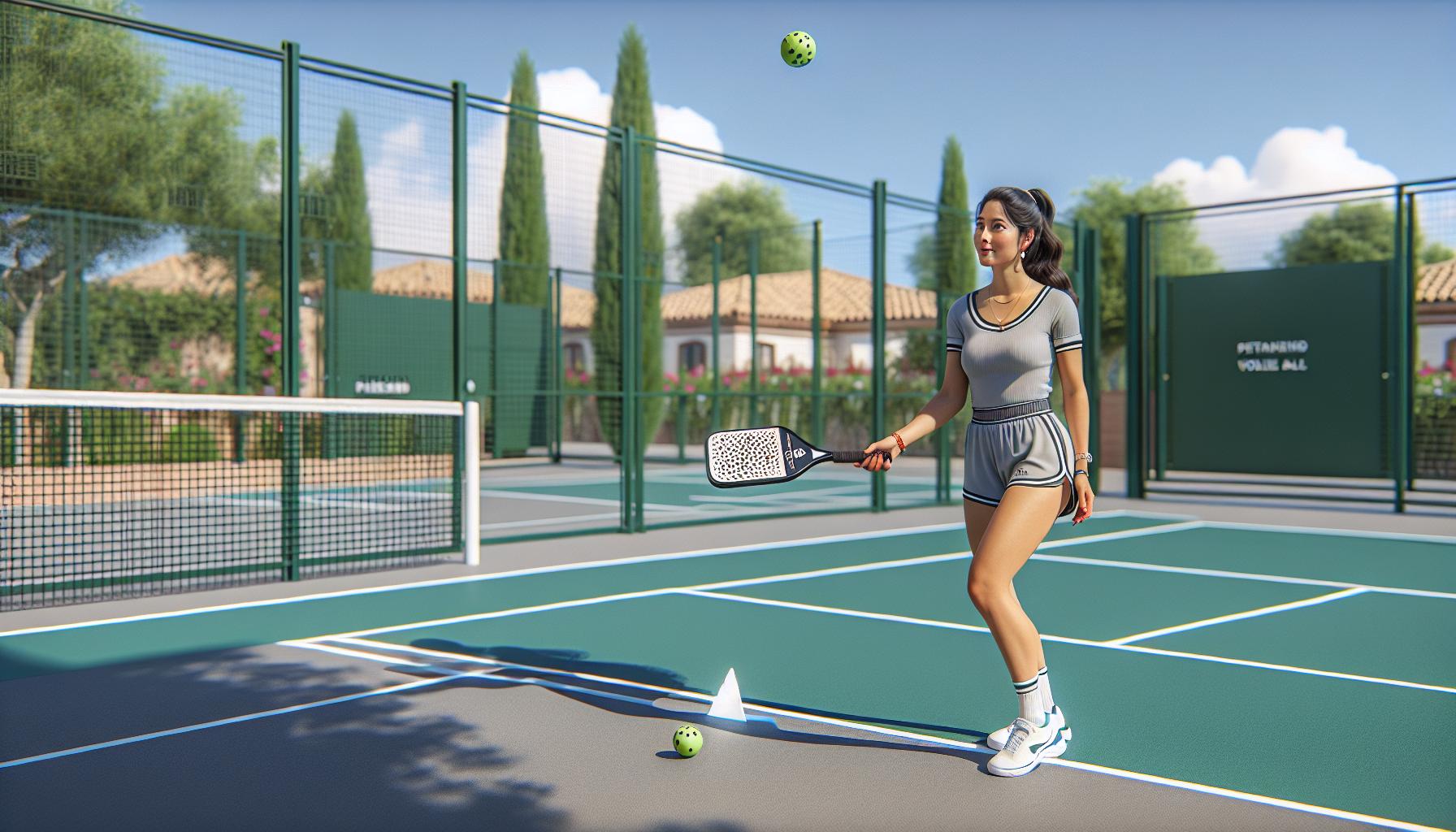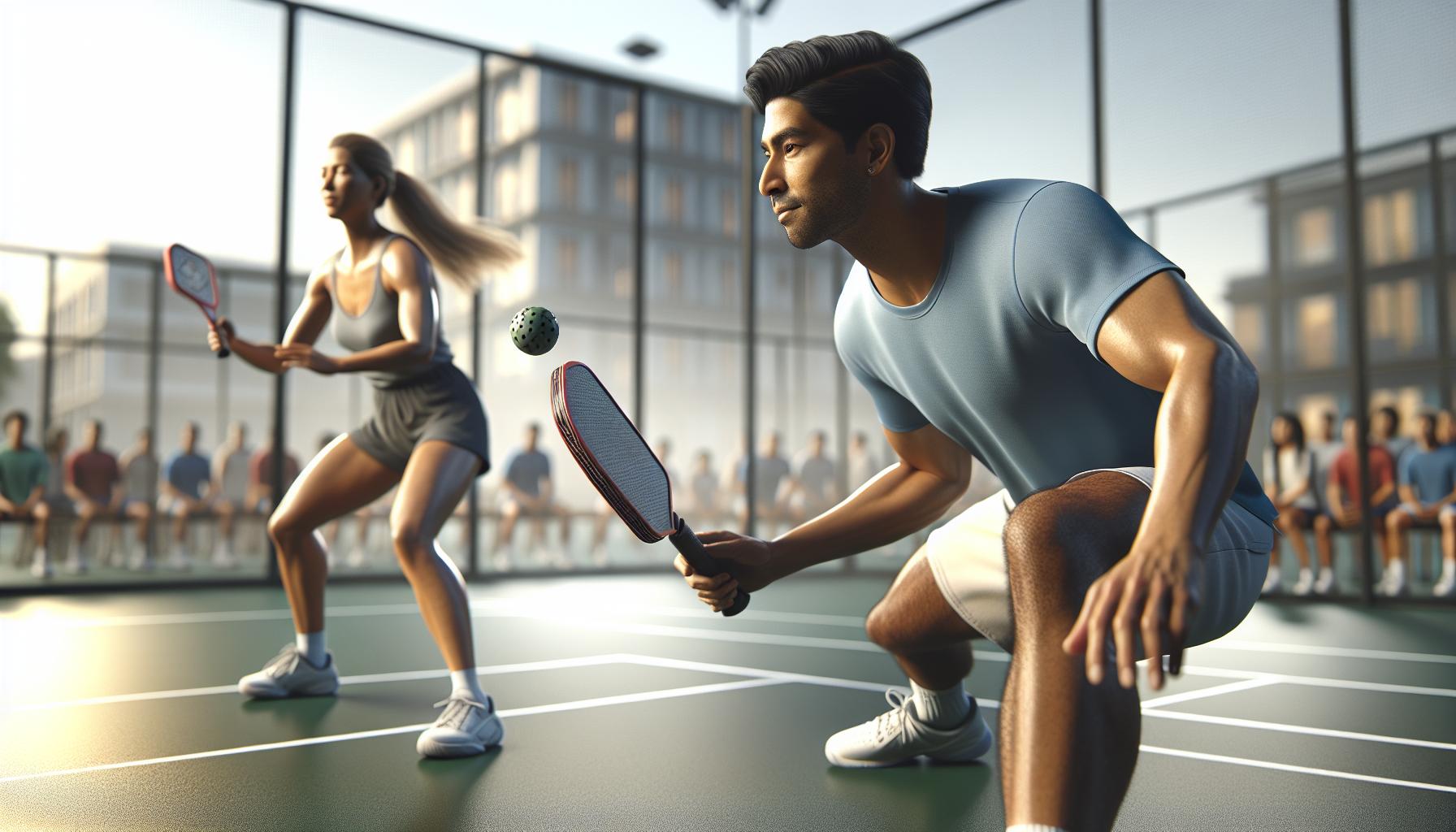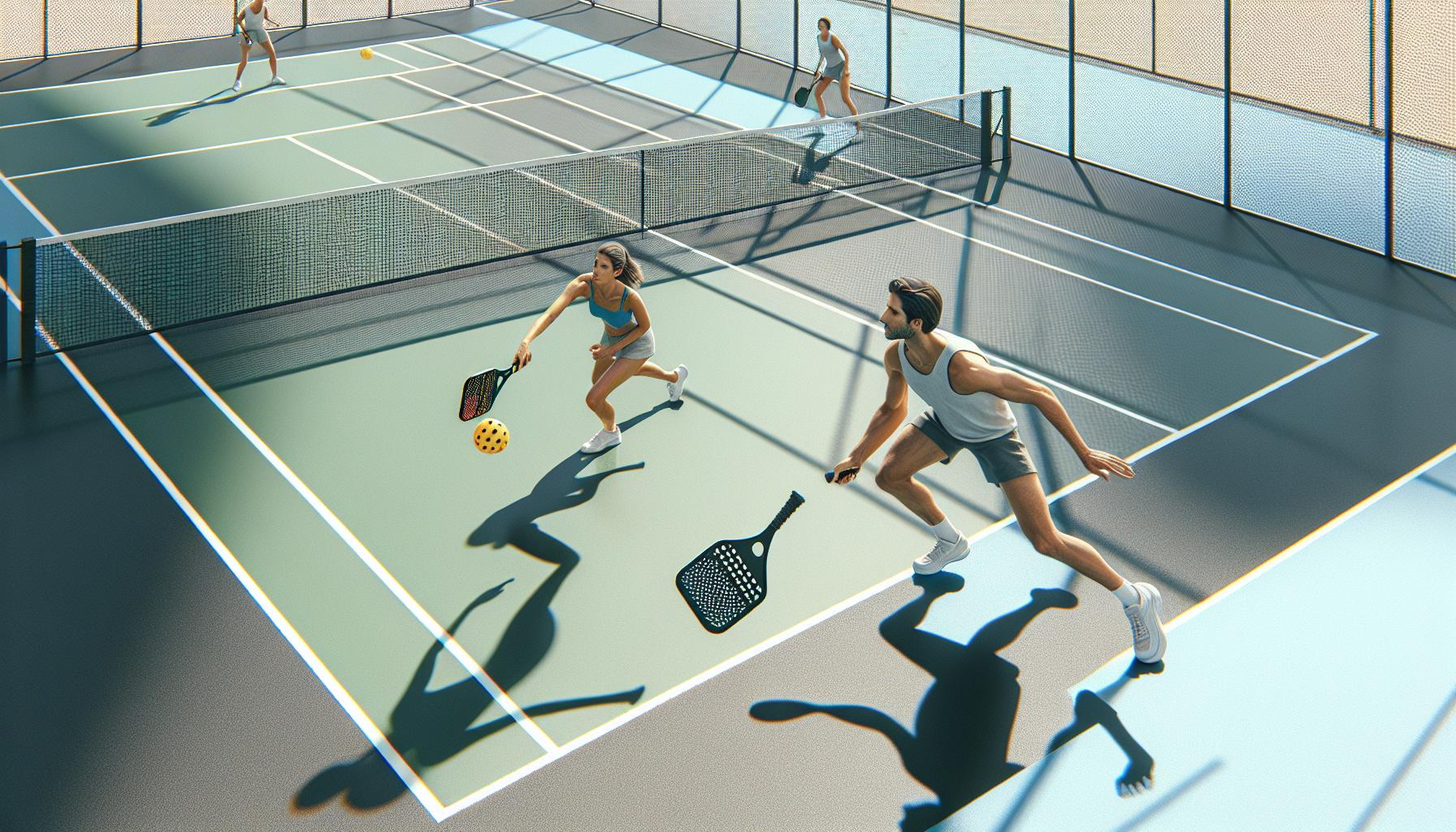Pickleball’s skyrocketing popularity isn’t just due to its fun, fast-paced gameplay; the unique rules, especially around the non-volley zone, or as it’s affectionately called, “the kitchen,” add a layer of strategy that’s both intriguing and a tad confusing for newcomers. Navigating these rules can feel like deciphering an ancient code, but fear not, they’re here to be simplified and demystified.
Understanding the non-volley zone rules is crucial for anyone looking to step up their game or just aiming to avoid those awkward moments when you’re not quite sure if you’ve just committed a pickleball faux pas. They’ll break it down, making it as easy as pie, ensuring you’ll be confidently playing by the book—or in this case, by the court.
Importance of Non-Volley Zone in Pickleball
The non-volley zone, affectionately known as “the kitchen,” holds a pivotal role in pickleball play. It’s a distinctive feature that sets pickleball apart from other racket sports, offering a unique blend of strategic depth and accessibility that appeals to players of all skill levels. This section of the court is not just another part of the game; it’s the heart of what makes pickleball both challenging and immensely enjoyable.
Why the Kitchen Matters
First, the non-volley zone encourages players to think ahead and strategize. A key aspect of winning points in pickleball involves positioning and the ability to control the pace and flow of the game. Players can’t simply rely on raw power or speed; they must also employ clever positioning and shot selection to outmaneuver their opponents.
Moreover, the kitchen levels the playing field between players of varying physical abilities. Because power shots from the non-volley zone are off-limits, players must instead focus on finesse, control, and precision. This emphasis on skill over strength makes pickleball uniquely inclusive, allowing younger players and seniors to compete on more equal footing.
Basic Rules Around the Non-Volley Zone
To truly understand the importance of the non-volley zone, one must grasp its basic rules:
- Players are prohibited from volleying the ball (hitting it in the air before it bounces) while standing in or touching the non-volley zone line.
- A volley is a legal shot if the player’s feet are behind the non-volley zone line at the time of contact, even if their momentum carries them into the kitchen afterward—as long as the ball was struck outside the zone.
- The non-volley zone applies to both the player and any object they’re in contact with; for instance, if a player’s paddle or clothing touches the zone during a volley, it results in a fault.
Strategic Use of the Kitchen
Understanding the non-volley zone’s rules isn’t just about avoiding faults; it’s also about leveraging the kitchen to create strategic advantages. Skilled players can use soft shots, known as “dinks,” to force their opponents into vulnerable positions, setting up opportunities for more aggressive plays. These battles of patience and positioning around the kitchen often determine the outcome of rallies.
What is the Non-Volley Zone?

The non-volley zone in pickleball, affectionately known as “the kitchen,” is a term that’s both whimsical and misleading. Spanning a vital 7 feet from the net on either side, this area defines a critical aspect of pickleball strategy and skill. Unlike in other racket sports, players must navigate this unique feature with a combination of finesse and strategic foresight.
At its core, the non-volley zone seeks to level the playing field. It prevents players from executing smashes from a position too close to the net, a rule that adds a layer of complexity to the game. Instead of relying solely on power, players are encouraged to craft a more nuanced game plan. They must think several moves ahead, anticipating their opponent’s strategies while concocting their own. This zone, therefore, is not just a physical boundary but a battleground of wits.
Understanding the kitchen’s dimensions is crucial for every pickleball player. The area extends 20 feet in width, matching the width of the doubles sideline, and 7 feet in depth from the net on both sides. This exact measurement creates a buffer zone that players cannot enter to volley the ball (hitting it before it bounces). The rules governing this space are clear: while a player can enter the kitchen at any time, they cannot volley the ball if any part of their body or paddle is in or touches the line of the non-volley zone when making the shot.
Navigating the Kitchen: Essential Strategies
Expert players harness the kitchen’s strategic potential by mastering the art of the “dink,” a soft shot that lands in the opponent’s kitchen, forcing them to volley from a less advantageous position. Here’s where the depth of strategy in pickleball reveals itself. A well-placed dink can draw an opponent into the kitchen at an inopportune time, potentially leading to a fault or setting up the player for a winning shot.
Moreover, understanding and exploiting the non-volley zone enables players to better position themselves for both offensive and defensive play. Defensively, maintaining a position just behind the kitchen line allows players to cover the court more effectively, ready to respond to an opponent’s dinks or power shots. Offensively, players can use soft shots to maneuver their opponents out of position, creating openings for more aggressive play.
Non-Volley Zone Rules Simplified

Pickleball’s non-volley zone, affectionately known as “the kitchen,” is often where games are won or lost. Its unique rules set it apart from other areas on the court, creating a hotbed of strategic play. Understanding and adhering to these rules is key for players who aim to master the game.
Firstly, the basic premise of the non-volley zone is that players are prohibited from performing volleys—that is, hitting the ball before it bounces—while standing within this 7-foot zone on either side of the net. This rule forces players to adopt a more nuanced approach, relying on skillful placements rather than sheer power.
To delve a bit deeper, if a player’s momentum from a volley carries them into the kitchen, even after the ball is hit, it’s considered a fault. This subtlety demands high levels of control and awareness from the players, enhancing the strategic aspect of the game.
- Volleys are prohibited in the non-volley zone. Players must let the ball bounce once if they are within this zone.
- Momentum rules apply. If you volley the ball and your momentum takes you into the kitchen, it’s a fault.
- All parts matter. Any part of a player’s body or equipment touching the zone during the volley results in a fault.
It’s also important to note that these rules do not apply to balls that have bounced in the non-volley zone. Once the ball bounces, players are free to step into the kitchen to hit the ball—even if it’s on the fly.
Understanding the intricacies of the non-volley zone rules can significantly impact a player’s strategy. For instance, the “dink” shot—a soft, arced shot that lands in the opponent’s kitchen—is a strategic maneuver used to pull opponents forward, setting up opportunities for winning shots. Mastery of such techniques can greatly enhance a player’s effectiveness on the court.
For beginners, the non-volley zone rules may seem daunting at first. However, like any aspect of the game, practice and experience bring clarity. Engaging in drills that focus on control and placement, rather than power, can help players get accustomed to the dynamics of the kitchen.
Strategies for Playing Around the Non-Volley Zone

Mastering the game of pickleball involves not just understanding the rules but also devising strategies to leverage the non-volley zone, commonly known as “the kitchen,” to one’s advantage. This critical part of the court can be a battleground of wits, requiring players to think a step ahead and execute their shots with precision and control.
Essential Shots
When dealing with the non-volley zone, certain shots become invaluable tools in a player’s arsenal:
- The Dink Shot: A soft, arc shot aimed just over the net into the opponent’s kitchen. It’s designed to be difficult to return with power, forcing the opponent closer to the net and potentially creating opportunities for the offensive player to exploit.
- The Lob: Targeted over the opponent’s head, the lob can push them back from the net, allowing the lobber to gain control of the kitchen. Used sparingly, it keeps opponents guessing.
- Drop Shots: From a position near the baseline, a well-placed drop shot into the non-volley zone forces the opponent to rush forward, often resulting in a less controlled return.
Positioning and Movement
Success in utilizing the non-volley zone doesn’t rely on shots alone. Effective positioning and movement are just as crucial.
- Players should aim to control the point from just behind the non-volley zone line, moving up to volley when it’s safe and legal, but always being prepared to step back for a groundstroke.
- Anticipating the opponent’s shots and moving quickly to counteract them is key. Agility and quick reflexes can turn a defensive position into an offensive opportunity.
- Communication in doubles is essential. Teammates should call shots and movements clearly, ensuring that both players aren’t drawn into the kitchen unnecessarily, which can leave wide areas of the court exposed.
Psychological Play
The mental aspect of the game plays a significant role, especially around the kitchen.
- Keeping opponents on their toes with varied shots can lead to hesitation and mistakes. Mixing up dinks, lobs, and drives keeps defenders guessing.
- Confidence at the line can pressure opponents, making them more susceptible to unforced errors. Maintaining a composed yet aggressive stance at the kitchen line can be intimidating.
- Patience is often the winning strategy. Successfully navigating a volley exchange requires players to wait for the perfect opportunity to introduce a winning shot. Rushing or becoming overly aggressive can lead to mistakes
Mastering Non-Volley Zone to Improve Your Pickleball Game

In the fast-paced game of pickleball, mastering the area known as “the kitchen” or the non-volley zone can drastically enhance a player’s performance. This crucial 7-foot zone adjacent to the net is where strategy overpowers strength, and tactful play trumps raw power. Players who excel in this zone not only increase their chances of winning points but also elevate their overall gameplay.
Understanding the Rules is the first step to mastering the non-volley zone. Players are prohibited from volleying the ball—that is, hitting it before it bounces—while standing within this zone. This rule prevents aggressive smashes from close range, encouraging a more nuanced style of play. It’s essential for players to recognize that while they can’t volley in this zone, they can still enter it to play balls that have bounced. Timing and footwork, therefore, become crucial elements in executing shots from the kitchen effectively.
Essential Shots from the Kitchen
- Dink Shot: A soft, arc shot aimed to land in the opponent’s kitchen. It’s a fundamental shot designed to minimize the opponent’s attack options.
- Drop Shot: A shot that aims to clear the net with just enough height and then drops into the non-volley zone, ideally forcing opponents back to the baseline.
- Lob: An overhead shot that sends the ball high into the air, intended to push the opponent away from the net.
To effectively use the non-volley zone, players must practice these shots until they can execute them with precision and minimal effort. Each shot serves a strategic purpose, allowing players to control the pace and direction of the game.
Positioning and Movement
Proper positioning around the non-volley zone is as crucial as mastering the shots. Players should strive to maintain a position close to the boundary of the zone, ready to step back for a lob or step in for a dink or drop shot. Quick lateral movements and seamless transitions in and out of the kitchen enable players to cover more ground and respond to their opponents’ shots more effectively.
Psychological Warfare
Playing effectively in the non-volley zone also involves a psychological component. Keeping opponents guessing with a variety of shots from the kitchen can frustrate and tire them out, making it easier to find gaps in their defenses. Confidence at the line, combined with patience, often leads to forcing errors or opening opportunities for winning shots.
Conclusion
Mastering the non-volley zone is a game-changer in pickleball. It’s not just about knowing the rules but applying them with strategic timing, precise footwork, and a variety of shots. Practicing the Dink Shot, Drop Shot, and Lob can significantly enhance one’s gameplay. Moreover, understanding the psychological play of keeping opponents guessing with varied shots is crucial. Remember, it’s the smart positioning and movement that often lead to winning opportunities. So, keep practicing and refining these skills to elevate your pickleball game to the next level.














0 Comments